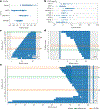Analysis and benchmarking of small and large genomic variants across tandem repeats
- PMID: 38671154
- PMCID: PMC11952744
- DOI: 10.1038/s41587-024-02225-z
Analysis and benchmarking of small and large genomic variants across tandem repeats
Abstract
Tandem repeats (TRs) are highly polymorphic in the human genome, have thousands of associated molecular traits and are linked to over 60 disease phenotypes. However, they are often excluded from at-scale studies because of challenges with variant calling and representation, as well as a lack of a genome-wide standard. Here, to promote the development of TR methods, we created a catalog of TR regions and explored TR properties across 86 haplotype-resolved long-read human assemblies. We curated variants from the Genome in a Bottle (GIAB) HG002 individual to create a TR dataset to benchmark existing and future TR analysis methods. We also present an improved variant comparison method that handles variants greater than 4 bp in length and varying allelic representation. The 8.1% of the genome covered by the TR catalog holds ~24.9% of variants per individual, including 124,728 small and 17,988 large variants for the GIAB HG002 'truth-set' TR benchmark. We demonstrate the utility of this pipeline across short-read and long-read technologies.
© 2024. The Author(s), under exclusive licence to Springer Nature America, Inc.
Conflict of interest statement
Competing interests: F.J.S. receives research support from Illumina, Genentech, PacBio and ONT. E.D. and M.A.E. are employees and shareholders of PacBio. S.K.M. is an employee and shareholder of ONT. W.D.C. has received free consumables from ONT. The other authors declare no competing interests.
Figures




Update of
-
Benchmarking of small and large variants across tandem repeats.bioRxiv [Preprint]. 2023 Nov 1:2023.10.29.564632. doi: 10.1101/2023.10.29.564632. bioRxiv. 2023. Update in: Nat Biotechnol. 2025 Mar;43(3):431-442. doi: 10.1038/s41587-024-02225-z. PMID: 37961319 Free PMC article. Updated. Preprint.
References
MeSH terms
Grants and funding
LinkOut - more resources
Full Text Sources

